I have spent a lot of time the past 3-4 months creating / improving my first circuit design which is a bldc motor driver circuit. I finally have a prototype which I think will work:
Before I physically build this circuit I want to know whether or not it is possible to simulate this circuit in a simulator? The only part I'm uncertain about in this design is the bootstrap capacitor circuit and the gate resistor value. I'm not sure if I have the correct values of all those components so that's why I want to simulate it before building it.
I downloaded LTSpice and watched a few Youtube videos on it, but it doesn't really seem like its possible to simulate an entire circuit like this. It seems like LTSpice is for simpler circuits and it can only simulate small portions of my circuit.
I also looked at simulating it in Simulink, but it doesn't seem like I could really test out the bootstrap capacitor circuit for my FAN7392N ic. I saw that I can simulate a BLDC motor with the block diagrams they have, but I'm not sure how I would be able to test the bootstrap capacitor circuit in my diagram.
Is there a way to test this circuit in a simulator before physically building it? Or is the only way to test it to physically build it?
I'm just a little worried because if the circuit doesn't work it's going to be really annoying to figure out if my circuit design is the problem, or if my soldering skills are the problem.
If I am able to simulate this circuit could you point me in the right direction?
